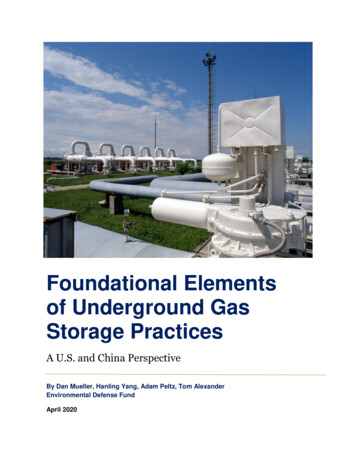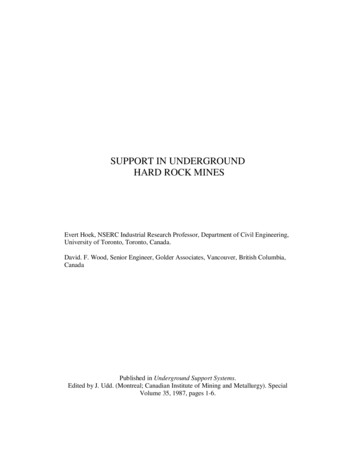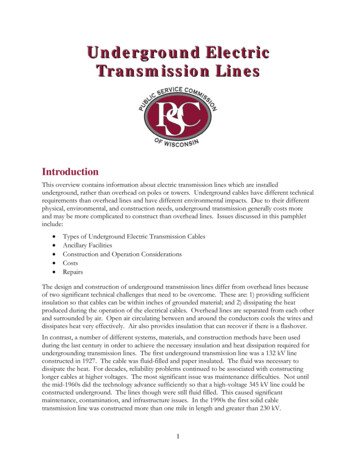
Transcription
Foundational Elementsof Underground GasStorage PracticesA U.S. and China PerspectiveBy Dan Mueller, Hanling Yang, Adam Peltz, Tom AlexanderEnvironmental Defense FundApril 2020
Foundational Elements of Underground Gas Storage Practices – A U.S. and China PerspectiveTable of ContentsExecutive Summary 21.0 Introduction . . . 52.0 Underground Gas Storage in the United States Overview: Some Basic Tenets . .73.0 Current Underground Gas Storage Technical and Regulatory Guidance . .134.0 Underground Gas Storage in China . .225.0 Key Recommended Elements of a Robust Underground Gas Storage Regulatory Program . 30Approval of Underground Gas Storage Projects . 30Risk Management Plans . . . . 31Emergency Response Plan . . 33Underground Gas Storage Project Information Disclosure . . 34Wellbore Diagrams . 35Evaluation of Wells Within the Area of Review (AOR) . 36Records Management . 36Well Construction Requirements . 36Mechanical Integrity Testing . 37Pressure Testing Parameters . 38Monitoring Requirements . . 38Inspection, Testing, and Maintenance of Wellheads and Valves . 39Well Leak Reporting . 40Requirements for Decommissioning . 40Management of Change . 416.0 Conclusions and Follow-on Efforts . 43Appendix A –China National and China National Petroleum Corporation Standards for Underground Gas Storage . 45Appendix B –Depiction of Emission Sources During Underground Gas Storage Facility Construction and Operation.48Page 1 of 53
Foundational Elements of Underground Gas Storage Practices – A U.S. and China PerspectiveExecutive SummaryThe Environmental Defense Fund developed this report on current conditions and practices ofunderground gas storage (UGS) in the United States and China with a forward-lookingperspective on key elements needed to develop a more comprehensive UGS regulatory program.UGS is key to an effective and reliable gas supply providing operational flexibility to meet anever-changing supply and demand, notably when supply may be curtailed due to natural orgeopolitical reasons. Critical to UGS is a robust regulatory program addressing all phases ofoperation for the protection of environment, human health and safety.The United States has a long history of UGS dating back to the early 1900s and over this timeperiod has developed a mature regulatory framework and supporting technical references toguide permitting, design, construction, operations, and decommissioning (including regulatoryoversight, and non-compliance enforcement actions). Good, comprehensive technicalreferences include (but certainly are not limited to) American Petroleum Institute (API)Recommend Practices documents (specifically API RP 1170 and API RP 1171)1, 2, CanadianStandards Association’s (CSA) “Storage of Hydrocarbons in Underground Formations”3 and theInterstate Oil and Gas Compact Commission and Ground Water Protection Council’s“Underground Gas Storage Regulatory Considerations”.4In the U.S., regulatory requirements fall under both federal and state jurisdictions andalthough many of the regulatory programs have been in place for many years withimprovements evolving over the past two decades, significant unplanned releases ofstored gas into the environment have occurred as a result of facility failures, which haddisastrous impacts on environment, public health and safety. Most recently, a blowoutof a well in 2015 at the Aliso Canyon facility located in California resulted in 6,600million cubic feet (MCF) (187 million cubic meters (MCM))5 of natural gas released over111 days and required the evacuation of over 8,000 households. The resultant naturalgas release was the largest un-combusted leakage in U.S. history and roughly equivalentto the annual natural gas usage of 190,000 Los Angeles homes6. In response to the AlisoCanyon failure, significant regulatory revisions were initiated and in 2016, the Pipelineand Hazardous Materials Safety Administration (PHMSA), a U.S. federal agency, issueda nationwide interim final rule for UGS facilities with final rules announced in FebruaryPage 2 of 53
Foundational Elements of Underground Gas Storage Practices – A U.S. and China Perspective2020.7 More recently a few states have revised their UGS rules or have plans to do so.California is one of those states, and in 2018 issued revised rules incorporating API RP1170 and API 1171 with several leading management practices including greatlyexpanded requirements for risk management, emergency response planning, and robusttesting and monitoring programs and protocols.Comparing with the U.S., China is still a newcomer in UGS development. China’s first UGSfacility was built in 1969 though the first large-scale project did not occur until 1999.8 Currentlythere are 27 UGS facilities9 in China providing storage capacity of 14 bcm at the end of 2019,about 4.5% of the country’s annual consumption.10 However, plans are in place to significantlyincrease UGS capacity to 30bcm, about 6% of expected annual consumption by 2030, roughlydoubling current capacity in just over 10 years.11China’s environmental regulations cover a wide range of items and issues important to UGS, andChina also leads the world in a number of UGS technologies. However, as evidenced by recentevents in the Unites States, a process of continual improvement of regulatory frameworks,technical guidance, operations, and regulatory oversight are critical to maintaining programsand processes that are up-to-date and reflect the latest thought on best practices.This report presents key elements of a regulatory program, building upon the most recentCalifornia regulatory revisions that were driven by the Aliso Canyon incident, the adoption ofPHMSA’s final minimum uniform federal safety standards, technical and regulatory guidance(including API RPs, Canadian Standards, GWPC report), as well as recommendations by bothUS and Chinese experts on this topic. The key elements address: Permitting and permitting approval (including on-going inspections and permit reviewas part of facility operation); Facility siting; Risk management planning; Emergency response planning; Data collection and records management; Technical requirements for construction and operation; Leak reporting (including appropriate level of root case analysis of facility of operationfailure); Integrity testing and monitoring; and Decommissioning.Page 3 of 53
Foundational Elements of Underground Gas Storage Practices – A U.S. and China PerspectiveIncorporated in all the key elements is management of change - a leading management practicedirected at making sure environmental, health and safety risks are addressed whenever changesoccur in management organization or facility operation. Proper protocols for management ofchange are essential to ensure any changes do not increase existing risks and that new risks areidentified, addressed, implemented timely and communicated to all stakeholders.Key regulatory elements presented in this report provide a basis for developing a robust UGSregulatory program. However, there are areas that can be further developed, particularly inconsideration of specific siting and storage conditions. This report identifies the need forfurther detailed analysis of U.S. and China UGS permitting requirements to pinpoint areas ofimprovement of the respective country’s regulatory framework.Page 4 of 53
Foundational Elements of Underground Gas Storage Practices – A U.S. and China Perspective1.0 IntroductionCritical to a reliable supply of natural gas is storage that provides a buffer between fluctuatingsupply and end use. Sourcing of natural gas originating from either production facilities orimporting from other production areas will not normally be at a constant rate. Additionally (andLikely more significantly), the differences between natural gas consumption and supply varybased on daily and seasonal needs by end users as well as potentially more drastic fluctuationscaused by natural disasters or unforeseen disruption in a supply source (including geopoliticalincidents). UGS provides a buttress for both operational flexibility and allows for the properdesign and operation of critical gas transportation infrastructure (including pipelines).There are three primary types of UGS: depleted hydrocarbon reservoirs, aquifers, and saltcaverns. The majority of UGS occurs in depleted hydrocarbon reservoirs. These formationsexhibit relatively high permeability and porosity and by their very nature (since they originallyhoused hydrocarbon reserves) offer a high degree of storage integrity. The existing wells in thereservoir can be converted for gas storage use and additional wells drilled to add to the reservoirgas injection and withdrawal capacity as required.Aquifer storage is similar to depleted hydrocarbon reservoirs in terms of the nature of theporous rock media used to contain the gas and the methodology for assessing the reservoir.However, the geological characteristics of the aquifer formations are not as well-known as withhydrocarbon reserves requiring additional investigations to determine suitability prior todevelopment.Salt formations, typically in the form of salt beds or salt domes, can be well suited for UGS.Storage caverns are developed in these salt deposits using water to dissolve and remove aportion of the salt deposits leaving a large open volume (essentially a cavern).Natural gas figures to play an increasingly significant role in China’s strategy to combat air andclimate pollution. The percentage of natural gas is expected to increase from current 7% to 15%in the country’s primary energy mix by 2030.12 A quarter of the growth in global gas demandwill come from China in the next 20 years.13 Currently, imported gas accounts for 45% of thecountry’s gas supply.14 However, China’s existing underground gas storage is only 4.5%15 of thetotal annual consumption compared to approximately 18%16 for the U.S. and an internationalaverage of 10% – 12%.17 To balance gas supply and address supply bottlenecks (bothgeographical and seasonal), China is initiating a new wave of UGS projects. In April 2020, thePage 5 of 53
Foundational Elements of Underground Gas Storage Practices – A U.S. and China PerspectiveFive agencies including the National Development and Reform Commission and the Ministry ofFinance jointly issued the “Implementing Opinion on Accelerating Natural Gas Storage CapacityBuilding”, calling for speed-up of gas storage infrastructure construction.18 Compared with theUnited States, which has some of the world’s oldest and largest UGS facilities, China is arelatively newcomer to large-scale UGS with only about 20 years of experience.While guidance on UGS design and construction processes are mature and widely available,deviation from sound practices due to poor operating procedures or lax oversight will eventuallyresult in serious environmental, safety, and health effects as evidenced by the recent AlisoCanyon failure which triggered significant amendment of UGS regulations at both the state(California) and federal levels. China has a perfect window of opportunity to develop a worldclass UGS program, drawing on both engineering and technical design and operationalresources as well as well as experience and expertise from both the U.S. and China.A number of risks to the environment, safety, and human health can originate from surface andsubsurface operations including the following (some overlap in both cause and affect).Environmental Risks Loss of storage facility integrity (release of natural gas to subsurface formations and theatmosphere), Mechanical failures of surface infrastructure resulting in leaks and spills to theenvironment, and Damage to surface and subsurface infrastructure due to natural disasters.Safety and Human Health Risks Mechanical failure of surface infrastructure resulting in release of natural gas andresultant exposure to both workers and communities; Well blowouts, fires, explosions; Medical emergencies; and Noise and light pollution.Facility design, construction, and operation must consider these risks, including planning toanticipate and minimize occurrence and severity, as well as response actions to minimize andrecover from impacts. This requires more than just technical and engineering design andPage 6 of 53
Foundational Elements of Underground Gas Storage Practices – A U.S. and China Perspectivecontrols, but also health, safety and environment management processes (includingmanagement of change), risk management planning and emergency response planning. Theseare all addressed in the following sections.Page 7 of 53
Foundational Elements of Underground Gas Storage Practices – A U.S. and China Perspective2.0 Underground Gas Storagein the United StatesThe first UGS facility in the U.S. began operation in 1916. Since that time, UGS has expanded toover 400 facilities spread across 31 states. The vast majority of UGS occurs in depleted gasreservoirs (328 facilities accounting for approximately 80% of the working storage capacity)with the remaining storage capacity in aquifers and salt caverns.19Figure 1 shows UGS facilities in the U.S. Storage in depleted hydrocarbon reservoirs are locatedthroughout the U.S., while aquifer storage is more prevalent in the Midwest and salt cavernstorage is primarily in the G
Foundational Elements of Underground Gas Storage Practices – A U.S. and China Perspective Page 3 of 53 2020.7 More recently a few states have revised their UGS rules or have plans to do so. California is one of those states, and in 2018 issued revised rules incorporating API RP











